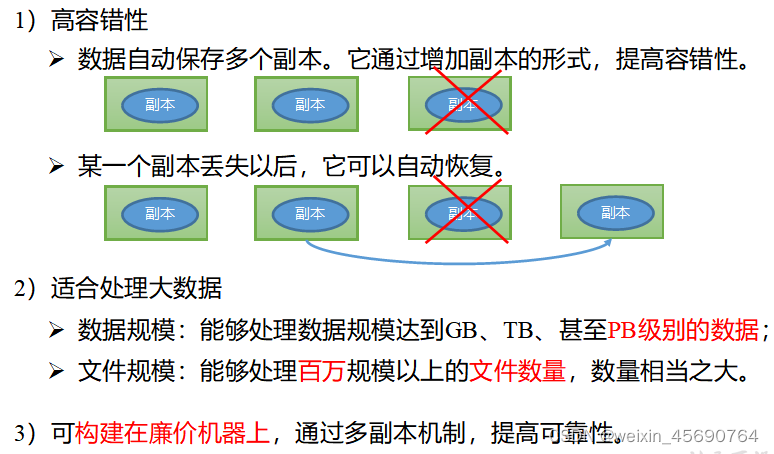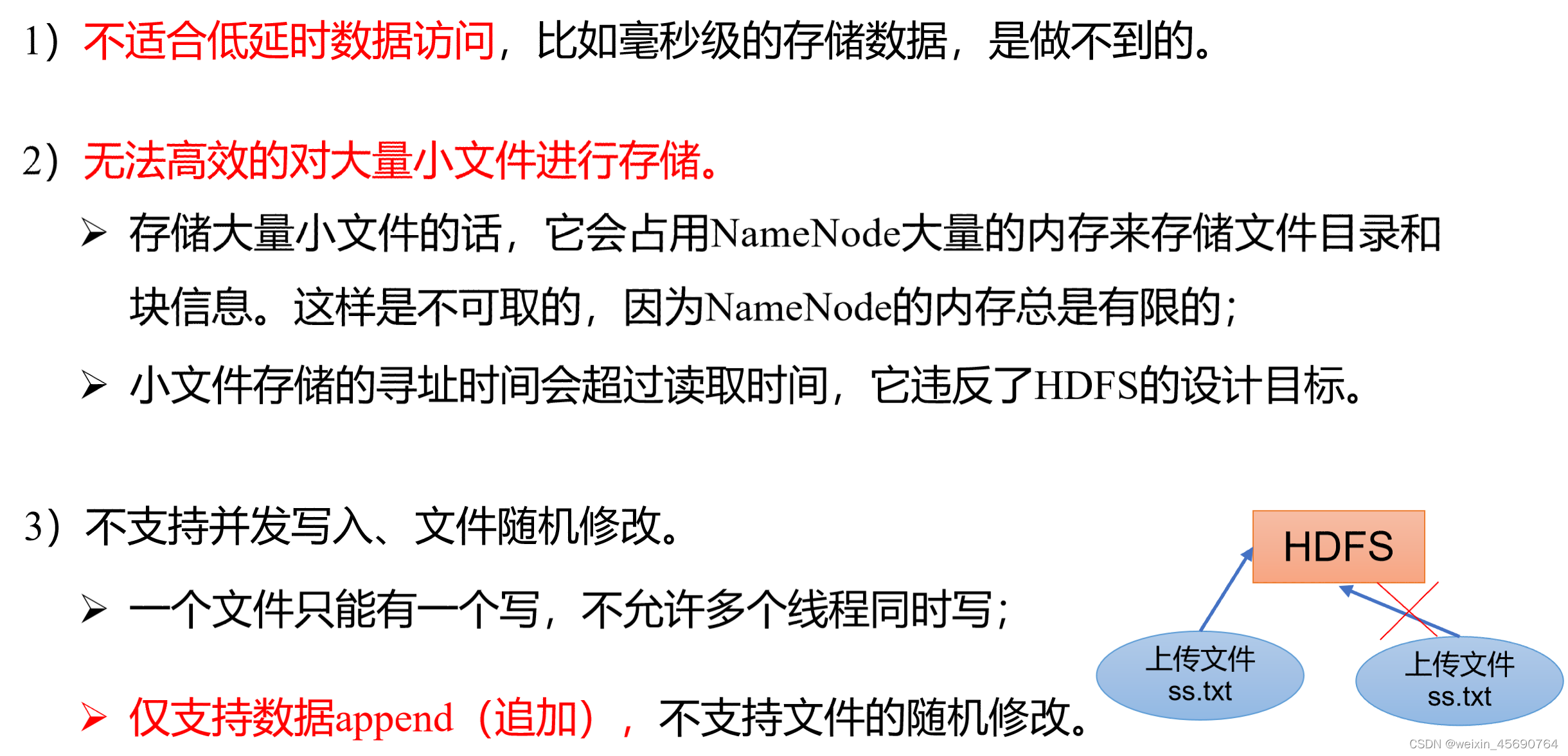第1章 HDFS
1.1 HDFS产生北京和意义
? 随着数据量越来越大,在一个操作系统存不下所有的数据,那么就分配到更多的操作系统管理的磁盘中,但是不方便管理和维护,迫切需要一种系统来管理多台机器上的文件,这就是分布式文件管理系统。HDFS只是分布式文件管理系统中的一种。
- HDFS(Hadoop Distributed File System):它是一个文件系统。用于存储文件,通过目录树来定位文件;其次,它是分布式的,由很多服务器联合起来实现其功能,集群中的服务器有各自的角色。
- 使用场景:适合一次写入,多次读出的场景。一个文件经过创建、写入和关闭之后就不需要改变。
1.2 HDFS优缺点
优点

缺点

1.3 HDFS组成架构

1.4 HDFS文件块大小(面试重点)

思考题:为什么块的大小不能设置太小,也不能设置太大?
- HDFS的块设置太小,会增加寻址实现,程序一直在找块的开始位置;
- 如果块设置的太大,从磁盘传输数据的时间会明显大于定位这个块开始位置所需要的时间。导致程序在处理这块数据时,会非常慢。
总结:HDFS块的大小设置主要取决于磁盘传输速度。
第2章 HDFS的Shell操作(开发重点)
2.1 基本语法
hadoop fs 具体命令 OR hdfs dfs 具体命令 – 两个是完全相同的。
2.2 命令大全
[atguigu@hadoop102 hadoop-3.1.3]$ bin/hadoop fs
[-appendToFile <localsrc> ... <dst>]
[-cat [-ignoreCrc] <src> ...]
[-chgrp [-R] GROUP PATH...]
[-chmod [-R] <MODE[,MODE]... | OCTALMODE> PATH...]
[-chown [-R] [OWNER][:[GROUP]] PATH...]
[-copyFromLocal [-f] [-p] <localsrc> ... <dst>]
[-copyToLocal [-p] [-ignoreCrc] [-crc] <src> ... <localdst>]
[-count [-q] <path> ...]
[-cp [-f] [-p] <src> ... <dst>]
[-df [-h] [<path> ...]]
[-du [-s] [-h] <path> ...]
[-get [-p] [-ignoreCrc] [-crc] <src> ... <localdst>]
[-getmerge [-nl] <src> <localdst>]
[-help [cmd ...]]
[-ls [-d] [-h] [-R] [<path> ...]]
[-mkdir [-p] <path> ...]
[-moveFromLocal <localsrc> ... <dst>]
[-moveToLocal <src> <localdst>]
[-mv <src> ... <dst>]
[-put [-f] [-p] <localsrc> ... <dst>]
[-rm [-f] [-r|-R] [-skipTrash] <src> ...]
[-rmdir [--ignore-fail-on-non-empty] <dir> ...]
<acl_spec> <path>]]
[-setrep [-R] [-w] <rep> <path> ...]
[-stat [format] <path> ...]
[-tail [-f] <file>]
[-test -[defsz] <path>]
[-text [-ignoreCrc] <src> ...]
2.3 常用命令操作
2.3.1 准备工作
1)启动Hadoop集群(方便后续的测试)
[atguigu@hadoop102 hadoop-3.1.3]$ sbin/start-dfs.sh
[atguigu@hadoop103 hadoop-3.1.3]$ sbin/start-yarn.sh
2)-help:输出这个命令参数
[atguigu@hadoop102 hadoop-3.1.3]$ hadoop fs -help rm
3)创建/sanguo文件夹
[atguigu@hadoop102 hadoop-3.1.3]$ hadoop fs -mkdir /sanguo
2.3.2 上传
1)-moveFromLocal:从本地剪切粘贴到HDFS
[atguigu@hadoop102 hadoop-3.1.3]$ vim shuguo.txt
输入:
shuguo
[atguigu@hadoop102 hadoop-3.1.3]$ hadoop fs -moveFromLocal ./shuguo.txt /sanguo
2)-copyFromLocal:从本地文件系统中拷贝文件到HDFS路径去
[atguigu@hadoop102 hadoop-3.1.3]$ vim weiguo.txt
输入:
weiguo
[atguigu@hadoop102 hadoop-3.1.3]$ hadoop fs -copyFromLocal weiguo.txt /sanguo
3)-put:等同于copyFromLocal,生产环境更习惯用put**(重要)**
[atguigu@hadoop102 hadoop-3.1.3]$ vim wuguo.txt
输入:
wuguo
[atguigu@hadoop102 hadoop-3.1.3]$ hadoop fs -put ./wuguo.txt /sanguo
4)-appendToFile:追加一个文件到已经存在的文件末尾
[atguigu@hadoop102 hadoop-3.1.3]$ vim liubei.txt
输入:
liubei
[atguigu@hadoop102 hadoop-3.1.3]$ hadoop fs -appendToFile liubei.txt /sanguo/shuguo.txt
2.3.3 下载
1)-copyToLocal:从HDFS拷贝到本地
[atguigu@hadoop102 hadoop-3.1.3]$ hadoop fs -copyToLocal /sanguo/shuguo.txt ./
2)-get:等同于copyToLocal,生产环境更习惯用get(重要)
[atguigu@hadoop102 hadoop-3.1.3]$ hadoop fs -get /sanguo/shuguo.txt ./shuguo2.txt
2.3.4 直接操作
1)-ls: 显示目录信息
[atguigu@hadoop102 hadoop-3.1.3]$ hadoop fs -ls /sanguo
2)-cat:显示文件内容
[atguigu@hadoop102 hadoop-3.1.3]$ hadoop fs -cat /sanguo/shuguo.txt
chgrp 改变用户组、chmod改变用户权限、chown改变所有者
3)-chgrp、-chmod、-chown:Linux文件系统中的用法一样,修改文件所属权限
[atguigu@hadoop102 hadoop-3.1.3]$ hadoop fs -chmod 666 /sanguo/shuguo.txt
[atguigu@hadoop102 hadoop-3.1.3]$ hadoop fs -chown atguigu:atguigu /sanguo/shuguo.txt
4)-mkdir:创建路径
[atguigu@hadoop102 hadoop-3.1.3]$ hadoop fs -mkdir /jinguo
5)-cp:从HDFS的一个路径拷贝到HDFS的另一个路径
[atguigu@hadoop102 hadoop-3.1.3]$ hadoop fs -cp /sanguo/shuguo.txt /jinguo
6)-mv:在HDFS目录中移动文件
[atguigu@hadoop102 hadoop-3.1.3]$ hadoop fs -mv /sanguo/wuguo.txt /jinguo
[atguigu@hadoop102 hadoop-3.1.3]$ hadoop fs -mv /sanguo/weiguo.txt /jinguo
7)-tail:显示一个文件的末尾1kb的数据
[atguigu@hadoop102 hadoop-3.1.3]$ hadoop fs -tail /jinguo/shuguo.txt
8)-rm:删除文件或文件夹
[atguigu@hadoop102 hadoop-3.1.3]$ hadoop fs -rm /sanguo/shuguo.txt
9)-rm -r:递归删除目录及目录里面内容
[atguigu@hadoop102 hadoop-3.1.3]$ hadoop fs -rm -r /sanguo
10)-du统计文件夹的大小信息(显示文件目录及子文件大小)
[atguigu@hadoop102 hadoop-3.1.3]$ hadoop fs -du -s -h /jinguo
27 81 /jinguo
[atguigu@hadoop102 hadoop-3.1.3]$ hadoop fs -du -h /jinguo
14 42 /jinguo/shuguo.txt
7 21 /jinguo/weiguo.txt
6 18 /jinguo/wuguo.tx
? 说明:27表示文件大小;81表示27*3个副本;/jinguo表示查看的目录
11)-setrep:设置HDFS中文件的副本数量
[atguigu@hadoop102 hadoop-3.1.3]$ hadoop fs -setrep 10 /jinguo/shuguo.txt
[外链图片转存失败,源站可能有防盗链机制,建议将图片保存下来直接上传(img-jj3dfwvw-1639145573073)(file:///C:\Users\10853\AppData\Local\Temp\ksohtml19728\wps2.jpg)]
? 这里设置的副本数只是记录在NameNode的元数据中,是否真的会有这么多副本,还得看DataNode的数量。因为目前只有3台设备,最多也就3个副本,只有节点数的增加到10台时,副本数才能达到10。
第3章 HDFS 的API操作
3.1 客户端环境准备
1)找到资料包路径下的Windows依赖文件夹,拷贝hadoop-3.1.0到非中文路径(比如d:\)。
2)配置HADOOP_HOME环境变量
[外链图片转存失败,源站可能有防盗链机制,建议将图片保存下来直接上传(img-wweNDQzc-1639145573074)(C:\Users\10853\AppData\Roaming\Typora\typora-user-images\image-20211210185010809.png)]
3)配置Path环境变量。
*注意:如果环境变量不起作用,可以重启电脑试试。*
[外链图片转存失败,源站可能有防盗链机制,建议将图片保存下来直接上传(img-5admeGYR-1639145573074)(C:\Users\10853\AppData\Roaming\Typora\typora-user-images\image-20211210185051699.png)]
4)在IDEA中创建一个Maven工程HdfsClientDemo,并导入相应的依赖坐标+日志添加
<dependencies>
<dependency>
<groupId>org.apache.hadoop</groupId>
<artifactId>hadoop-client</artifactId>
<version>3.1.3</version>
</dependency>
<dependency>
<groupId>junit</groupId>
<artifactId>junit</artifactId>
<version>4.12</version>
</dependency>
<dependency>
<groupId>org.slf4j</groupId>
<artifactId>slf4j-log4j12</artifactId>
<version>1.7.30</version>
</dependency>
</dependencies>
? 在项目的src/main/resources目录下,新建一个文件,命名为“log4j.properties”,在文件中填入
log4j.rootLogger=INFO, stdout
log4j.appender.stdout=org.apache.log4j.ConsoleAppender
log4j.appender.stdout.layout=org.apache.log4j.PatternLayout
log4j.appender.stdout.layout.ConversionPattern=%d %p [%c] - %m%n
log4j.appender.logfile=org.apache.log4j.FileAppender
log4j.appender.logfile.File=target/spring.log
log4j.appender.logfile.layout=org.apache.log4j.PatternLayout
log4j.appender.logfile.layout.ConversionPattern=%d %p [%c] - %m%n
5)创建包名:com.atguigu.hdfs
6)创建HdfsClient类
public class HdfsClient {
@Test
public void testMkdirs() throws IOException, URISyntaxException, InterruptedException {
// 1 获取文件系统
Configuration configuration = new Configuration();
// FileSystem fs = FileSystem.get(new URI("hdfs://hadoop102:8020"), configuration);
FileSystem fs = FileSystem.get(new URI("hdfs://hadoop102:8020"), configuration,"atguigu");
// 2 创建目录
fs.mkdirs(new Path("/xiyou/huaguoshan/"));
// 3 关闭资源
fs.close();
}
}
7)执行程序
客户端去操作HDFS时,是有一个用户身份的。默认情况下,HDFS客户端(hdfs://hadoop102:8020)API会从采用Windows默认用户访问HDFS,会报权限异常错误。所以在访问HDFS时,一定要配置用户。web端(http://hadoop102:9870)
org.apache.hadoop.security.AccessControlException: Permission denied: user=56576, access=WRITE, inode="/xiyou/huaguoshan":atguigu:supergroup:drwxr-xr-x
3.2 HDFS的API案例实操
3.2.1 HDFS文件上传(测试参数优先级)
1)编写源代码
@Test
public void testCopyFromLocalFile() throws IOException, InterruptedException, URISyntaxException {
// 1 获取文件系统
Configuration configuration = new Configuration();
configuration.set("dfs.replication", "2");
FileSystem fs = FileSystem.get(new URI("hdfs://hadoop102:8020"), configuration, "atguigu");
// 2 上传文件
fs.copyFromLocalFile(new Path("d:/sunwukong.txt"), new Path("/xiyou/huaguoshan"));
// 3 关闭资源
fs.close();
}
2)将hdfs-site.xml拷贝到项目的resources资源目录下
<?xml version="1.0" encoding="UTF-8"?>
<?xml-stylesheet type="text/xsl" href="configuration.xsl"?>
<configuration>
<property>
<name>dfs.replication</name>
<value>1</value>
</property>
</configuration>
3)参数优先级
? 参数优先级排序:(1)客户端代码中设置的值 >(2)ClassPath下的用户自定义配置文件 >(3)然后是服务器的自定义配置(xxx-site.xml) >(4)服务器的默认配置(xxx-default.xml)
3.2.2 HDFS文件下载
@Test
public void testCopyToLocalFile() throws IOException, InterruptedException, URISyntaxException{
// 1 获取文件系统
Configuration configuration = new Configuration();
FileSystem fs = FileSystem.get(new URI("hdfs://hadoop102:8020"), configuration, "atguigu");
// 2 执行下载操作
// boolean delSrc 指是否将原文件删除
// Path src 指要下载的文件路径
// Path dst 指将文件下载到的路径
// boolean useRawLocalFileSystem 是否开启文件校验
fs.copyToLocalFile(false, new Path("/xiyou/huaguoshan/sunwukong.txt"), new Path("d:/sunwukong2.txt"), true);
// 3 关闭资源
fs.close();
}
? 注意:如果执行上面代码,下载不了文件,有可能是你电脑的微软支持的运行库少,需要安装一下微软运行库。
3.2.3 HDFS文件更名和移动
@Test
public void testRename() throws IOException, InterruptedException, URISyntaxException{
// 1 获取文件系统
Configuration configuration = new Configuration();
FileSystem fs = FileSystem.get(new URI("hdfs://hadoop102:8020"), configuration, "atguigu");
// 2 修改文件名称
fs.rename(new Path("/xiyou/huaguoshan/sunwukong.txt"), new Path("/xiyou/huaguoshan/meihouwang.txt"));
// 3 关闭资源
fs.close();
}
3.2.4 HDFS删除文件和目录
@Test
public void testDelete() throws IOException, InterruptedException, URISyntaxException{
// 1 获取文件系统
Configuration configuration = new Configuration();
FileSystem fs = FileSystem.get(new URI("hdfs://hadoop102:8020"), configuration, "atguigu");
// 2 执行删除
fs.delete(new Path("/xiyou"), true);
// 3 关闭资源
fs.close();
}
3.2.5 HDFS 文件详情查看
? 查看文件名称、权限、长度、块信息
@Test
public void testListFiles() throws IOException, InterruptedException, URISyntaxException {
// 1获取文件系统
Configuration configuration = new Configuration();
FileSystem fs = FileSystem.get(new URI("hdfs://hadoop102:8020"), configuration, "atguigu");
// 2 获取文件详情
RemoteIterator<LocatedFileStatus> listFiles = fs.listFiles(new Path("/"), true);
while (listFiles.hasNext()) {
LocatedFileStatus fileStatus = listFiles.next();
System.out.println("========" + fileStatus.getPath() + "=========");
System.out.println(fileStatus.getPermission());
System.out.println(fileStatus.getOwner());
System.out.println(fileStatus.getGroup());
System.out.println(fileStatus.getLen());
System.out.println(fileStatus.getModificationTime());
System.out.println(fileStatus.getReplication());
System.out.println(fileStatus.getBlockSize());
System.out.println(fileStatus.getPath().getName());
// 获取块信息
BlockLocation[] blockLocations = fileStatus.getBlockLocations();
System.out.println(Arrays.toString(blockLocations));
}
// 3 关闭资源
fs.close();
}
3.2.6 HDFS 文件和文件夹判断
@Test
public void testListStatus() throws IOException, InterruptedException, URISyntaxException{
// 1 获取文件配置信息
Configuration configuration = new Configuration();
FileSystem fs = FileSystem.get(new URI("hdfs://hadoop102:8020"), configuration, "atguigu");
// 2 判断是文件还是文件夹
FileStatus[] listStatus = fs.listStatus(new Path("/"));
for (FileStatus fileStatus : listStatus) {
// 如果是文件
if (fileStatus.isFile()) {
System.out.println("f:"+fileStatus.getPath().getName());
}else {
System.out.println("d:"+fileStatus.getPath().getName());
}
}
// 3 关闭资源
fs.close();
}